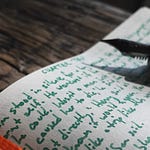Welcome back! Hopefully you’re starting this up having spent some time together learning about each other’s favorite stories... and maybe learned a little bit about each other.
Let's see what common ground the favorite stories share. Adventure? Humor? A really cool world where the story unfolds? We call that world building (which we’ll cover later).
Is there a genre or a type of story you both like? Fantasy, science-fiction, mystery, historical, or something else?
Pretty soon we're going to start walking you through the path almost every story takes, but we need to figure out what the starting line looks like. We can't get halfway into our story and realize there's time travel... or can we?
It's important to make sure we know the rules before we start breaking them.
Every good building needs a foundation to work from, and once we've figured out the rules of the world we're dealing with and the characters who get to live in this world.
Now, you don't have to have every detail figured out about your world in order to start telling a story. Not everyone can be J.R.R. Tolkien with his rich world built on languages, and honestly, I've known too many storytellers who have spent years and years trying to create a unique world and never even got word one of their story down on the page.
Sometimes you have to work backwards and figure out what is at the heart of the story in order to build a world around it.
For example, and apologies for some of the spoilers in my first book called The Wind Merchant, I wanted to tell a story about a father and a son reconnecting. I had recently moved away from my family, but had found that I was communicating more with my dad even though we lived 10 hours away instead of the twenty-five minute drive that we did for years. But I was also growing up and was trying to figure out what it must have been like for him when he was my age.
So I had this scene in my mind of a son and a father meeting around a similar age. I didn't want to write time travel (yet), so I created a world where there were bubbles where time stood still, and if you got stuck in one, the world moved by quickly around you.
So then I had to figure out WHY this world was built this way, what caused those time trap bubbles in a fantasy setting, and how the reunion would go between the two.
Maybe there was a scene or a moment that you both loved in one or both of the movies that you watched together. Obviously we don't want to rip anything off from other stories, but when we find out what moves us emotionally, that's a good clue as to what sort of story helps us figure out something deep down about ourselves.
Now I'm not suggesting that writing a story takes the place of therapy or other tools, but I think there is a lot of value in taking the time to examine when stories get you emotional and try to figure out why.
For me, parent and child stories really resonate... as you can see, I'm passionate about the power of story and how it can connect families.
By the way, don't worry if you are at a point and you don't have a main character in mind or a location or a world to build around them. We're still just gathering materials and exploring what it looks like for the two of you to connect creatively and find out what each other likes.
But fundamentally, you should try and identify if you want to write fantasy, mystery, or whatever you both like that will keep you interested and excited to tell this story. And parents, err on the side of letting your kiddo influence the direction here. You don't want to try and railroad a project through that they've lost interest in a while back.
Communication is important, and all of these lessons are designed to create some kind of discussion so you're learning more about each other and the stories you each love.
Activity: Story Tic-Tac-Toe
Let’s shake it up a little. There’s an exercise my daughter came up with all on her own that I think is absolutely brilliant. You know tic-tac-toe, right? Draw two lines vertically, two lines horizontally, first to get three in a row wins, right?
This is kind of the same idea, but after you draw your grid, I want one of you to go first and come up with one of the following:
A character, a time or place, an item, a genre (or a type of a story), and lastly I’ll leave some wiggle room to come up with something fun if the creative mood strikes you.
So for example, on the middle left, I wrote “Teddy bear.” My daughter chose the bottom left and wrote “1800s” as a time period that a story could be set in.
Then I wrote down in the bottom right “Mistaken identity” as a type of story. In the top left she wrote “long lost mansion” as a pace where a story could be set. Then we filled in the rest with things like a mysterious compass, time travel, an eccentric inventor, steampunk, and fiction land, which I left open to my daughter’s interpretation.
After all 9 squares have been filled in, take turns drawing a line that incorporates three of those things in a row and see if anything sets your imagination on fire.
You don’t have to commit to any of these ideas for your story, but it’s a fun example that sometimes when the two of you work together, you’ll come up with something you never would have thought of on your own.
Try it out a few times, see what you come up with, and jot down any ideas that seemed particularly fun or that you might want to use for later.
But hey, it’s almost the weekend! You completed your first week! I’m super proud of you, and so this weekend I want you to pick a night and watch a movie together that you both enjoy, and the next lesson will give you further instructions.
















Share this post